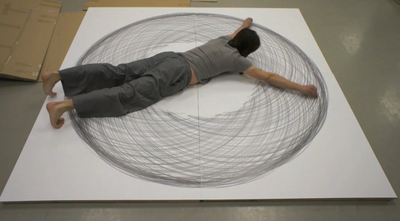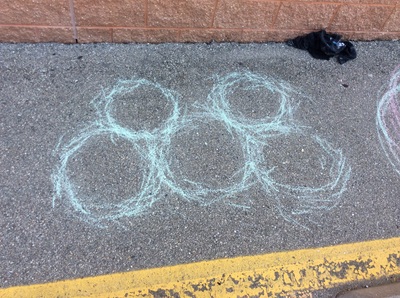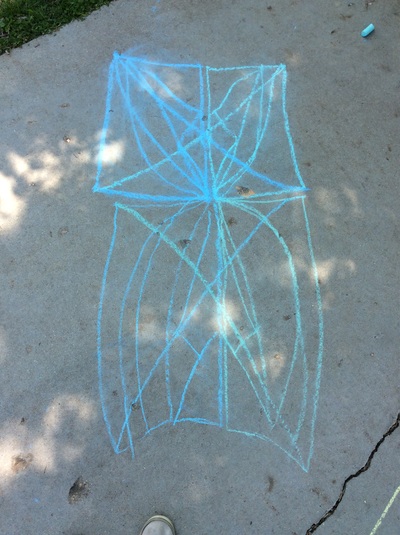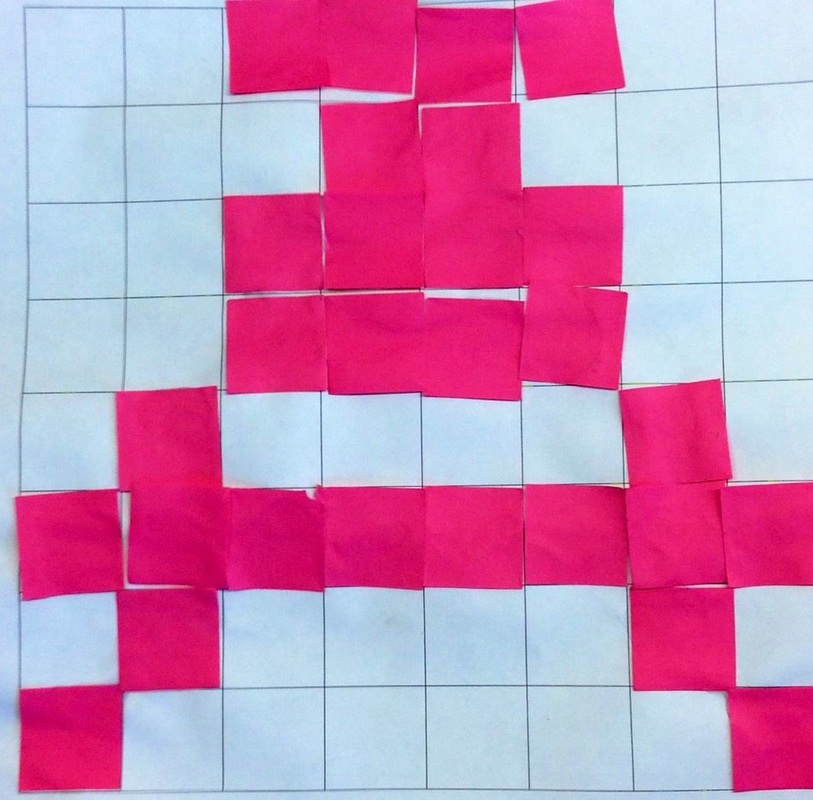|
2nd grade took a look at contemporary British artist, Damien Hirst. Damien has a wide variety of art but we focused on his spin paintings. Hirst has a table that spins in a circular motion. He puts paint onto the table and as it spins, it moves the paint around. Sometimes he takes the spin paintings and then cuts them into new shapes like the butterfly above. 2nd grade learns about butterflies in their classroom so I thought this would be a good tie in.
Although we don't have a spinning table, we used paper plates instead to create our spin paintings. Each student was given 2 plates. They used the primary colors and applied the paint thickly to their plate. Then they flipped their plate over onto a sheet of paper, pressed their finger in the center of the plate, and then rotated it. As the plate rotated, the primary colors mixed and created the secondary colors. The kids thought this was the raddest thing EVER! The next day, we took our 2 spin paintings and traced a circle around the edge of the paintings. Students cut out that circle and folded it in half so it looked like a taco. We then talked about symmetry and how a butterflies wings are the same on both sides. I showed them how to paint half of a butterfly with black paint and then fold their paper in half to print the other side of it. The last day, we cut out and glued our two butterflies down onto a strip of paper. I think doing it this way turned out better than how I did it last year. Last year, I had the kids try to paint the symmetry rather than just fold it in half and print it.
0 Comments
2nd grade took a look at contemporary British artist, Damien Hirst. Damien has a wide variety of art but we focused on his spin paintings. Hirst has a table that spins in a circular motion. He puts paint onto the table and as it spins, it moves the paint around. Sometimes he takes the spin paintings and then cuts them into new shapes like the butterfly above. 2nd grade learns about butterflies in their classroom so I thought this would be a good tie in.
Although we don't have a spinning table, we used paper plates instead to create our spin paintings. Each student was given 3 plates. They used the primary colors and applied the paint thickly to their plate. Then they flipped their plate over onto a sheet of paper, pressed their finger in the center of the plate, and then rotated it. As the plate rotated, the primary colors mixed and created the secondary colors. The kids thought this was the raddest thing EVER! The next day, we took our 3 spin paintings and traced a circle around the edge of the paintings. Students cut out that circle and folded it in half so it looked like a taco. We then talked about symmetry and how a butterflies wings are the same on both sides. I showed them how to draw half of a basic butterfly and cut it out. They were welcome to make more complicated butterflies. They thought it was awesome that after cutting it out and unfolding the plate, they now had a full butterfly! For future purposes, I need to find a more effective way of teaching how to draw a butterfly. The last day, we glued our three butterflies down onto a strip of paper. Then we used black paint to paint lines and shapes onto the wings, focusing on making them symmetrical. Tony Orrico is very similar to Heather Hansen in many ways. They are both artists/dancers. Both produce symmetrical. And both are kinetic artists (an artist who uses their whole body in the process). Orrico is sometimes referred to as the "Human Spirograph" because his artworks resemble them. Like with Heather Hansen, we talked about symmetry again and how he's not only making symmetrical marks on both sides of his body, but his compositions as a whole are symmetrical. I like how sometimes Orrico also works on walls and not just the ground. I showed students several different techniques that were inspired by him: we kneeled for some, laid down for some, and stood against a wall for some of the drawings. When I did this at Consolidated, I also did it with my 3rd graders and encouraged my 2nd and 3rd graders to overlap each other's work to create a more intricate design. So I had been looking at doing a project about Heather Hansen for a while but Don Masse over at shinebritezamorano.com beat me to the punch (his idea was cooler than mine though)! Heather Hansen is a kinetic artist which means that she moves around and involves her whole body in the art-making process. This is largely due to her background in not only art, but also in dance. Her work is very meditative and requires a lot of concentration and energy from her. Her work is also symmetrical. After discussing Heather Hansen and her symmetrical work with the kiddos, we got right to work! With one of my classes, I used a long sheet of black butcher paper so that everyone's work could fit on one huge banner. The class was split in two so that each person had a partner. One person would lead the activity. The leader would make symmetrical marks with each hand. This meant that students had to have a piece of chalk in each hand which threw them off a little at first. As the leader moved their hands symmetrically across the paper, their partner, who was sitting across from them, mirrored their movements. This created a bi-lateral symmetry. With another class, we went outside and made the drawings on sidewalk, layering colors on top of each other. This has been a long project for second grade so I am going to break it down into two blog posts, the second of which I will post next week. 2nd grade has been learning about the French street artist, Invader. Invader is an anonymous artist who uses small bathroom tiles to create mosaics of 8-bit video game characters. He is named after the old arcade game Space Invaders and is most well-known for portraying these in his street art. However, he has moved on to incorporate other video game characters such as Mario and Pac-Man. He likes to display his "invasions" in busy areas of cities due to their high traffic. He believes that everyone should be able to enjoy art, not just people who can afford to go to museums and galleries. I wanna be sure to stress, like our Keith Haring project, I did not condone street art. While I love it, I made sure to point out to students that this form of art is illegal and they would get in a lot of trouble if they tried it.
The first day and a half was spent looking at characters from the Space Invaders. We talked about how all the characters are symmetrical and made up of pixels (or small squares). We used gridded paper to re-create Space Invader characters. I wanted them to have a good understanding of how the Space Invaders were symmetrical before moving on to making their own. After a couple classes of re-creating old space invaders, students finally had the opportunity to create several of their own. My requirements were that it had to have an eye, be symmetrical, and it had to be 8 pixels high and 8 pixels wide. These requirements were to help the students with keeping their invader symmetrical. After a few days of gridded drawings of invaders, we chose our favorite invader that we had created and made a paper mosaic out of it. Throughout the project, we had discussed what a mosaic was. I used a die-cutter to create the squares for the paper mosaics so all of the colors are the same. This part of the project was done more so as a way to show me that they were ready to move on to the final stage of the unit: creating a clay invader. But we will save that for the next blog post! |
Devon CalvertHarmony and Consolidated Elementary Art Teacher in Milton, WI. UW-Eau Claire graduate. WAEA President. Apple Teacher. Archives
March 2019
Categories
All
|








































 RSS Feed
RSS Feed
